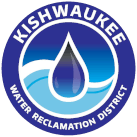Sewer System
The Sanitary Sewer Collection System
Each day, an average of 7 million gallons of wastewater flows through the sanitary sewers under DeKalb. During heavy rainfall, the volume can be as much as 10 times that.
Most of the public sewer mains are 8 inches in diameter. They feed into larger sewer mains that can be up to 18 inches. These drain into large interceptor sewers that can be up to 36 inches in diameter. The interceptors carry the sewage to the headworks of the treatment plant.
Sewer Tests
KWRD routinely monitors and evaluates the condition of our more than 150 miles of sanitary sewer mains. The average DeKalb sewer main is 50 years old, and while some of it is in excellent condition, much of it is not.
To identify places where mains need repairs, the District uses a combination of monitoring and evaluation tools. We use flow monitors to record how much water is flowing through a particular main. If the volume or speed dramatically increases after a rainfall, we know surface water is somehow leaking into the sanitary sewer.
Other ways we evaluate sewer conditions include inserting cameras into sewer lines to inspect them, introducing dye into adjacent storm sewers to look for cross-flooding, blowing nontoxic smoke into the main as a visual tracer, and manually inspecting manholes for signs they need repair.
Why We Test
The sanitary sewer was not designed to handle the volume of water that comes with rainfall. When surface water or groundwater leaks into the sanitary sewer, the main can quickly fill. Waste flowing into the main from private service laterals has no place to go, and a mixture of rainwater and sewage begins backing up through the drains of the lowest house in the neighborhood.
How It Impacts You
Residents should see little to no impact from KWRD testing. We do not need to access your home, and you can flush toilets and use water normally. When we are making repairs, you may notice barricades and digging around manhole covers or temporary traffic detours. Plantings over sewer easements may be disturbed.
Occasionally, the nontoxic dye we use to check for flooding from storm sewers can be visible in the Kishwaukee River when the stormwater is released. This dye is harmless to aquatic life, but it has been known to turn the river green.
Lift Stations - When Gravity Is Not An Option
Sometimes, the position of buildings relative to the nearest sewer main means the pipes can’t be slanted to the correct angle. That’s where the KWRD’s seven lift stations come into play.
Sewers drain wastewater into wells at the lift stations, just like they do at the headworks. The lift station wells are just much smaller. Pumps then lift the wastewater high enough for it to drain into the next level of sewer pipes, and gravity again takes over.
Lift stations require constant supervision to keep them operating and prevent overflow. Each station has a backup generator. The stations continuously send data about their operating status to the main plant through a computer system, so plant operators can respond quickly if something goes wrong.
Sewer Repairs
KWRD performs sewer reconstruction and rehabilitation every summer. The repairs are prioritized based on the results of the previous year's tests. Repairs may include:
- Sewer Lining - a material is inserted to create a smooth, watertight, long-lasting liner inside the old sewer pipe
- Pipe Replacement - A section of damaged pipe is dug up and replaced with a new pipe
- Manhole Repair - All or part of a manhole might be replaced or realigned and sealed
- Root Foaming - Pipes are treated with a substance to kill intruding tree roots; root cutters are also used throughout the year to clear away roots that threaten the water flow
How It Impacts You
When sewer pipes are relined or replaced, the new material needs 24 hours to cure before the main can be used again. The sewer connections in the area of the repair are sealed off for this 24-hour period.
While the pipes are sealed, sewage from those homes or businesses will stay in the private lateral and be unable to enter the public main. If your home is affected by a sewer repair, you will receive a notice – usually in the form of a door hanger – at least 24 hours in advance. The notice will ask you to refrain from doing laundry for 24 hours and to limit use of your sink, shower, and toilet as much as possible.
Not every home in the area will be affected, only those directly served by the pipes being repaired. If you do not receive a notice, you do not need to change your water use.
The lining material does have a chemical odor, but it should not be noticeable from inside your home unless your windows are open.
The main impact residents will notice from sewer repairs is the presence of work crews in the street. Traffic may be detoured while work is occurring.
Contact us
Footer form
We will get back to you as soon as possible.
Please try again later.
Kishwaukee Water Reclamation District | All Rights Reserved |
Created by Olive + Ash.
Managed by Olive Street Design.


